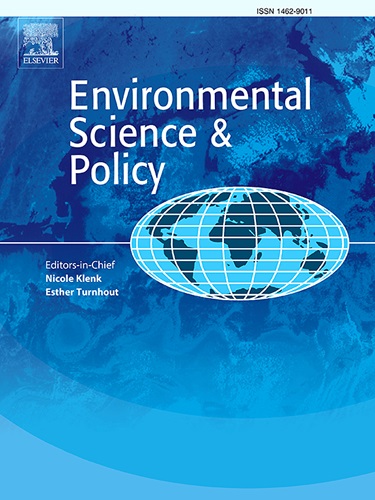评估欧盟二氧化碳减排战略对巴西土地生态系统和当地社区的潜在影响
IF 5.2
2区 环境科学与生态学
Q1 ENVIRONMENTAL SCIENCES
引用次数: 0
摘要
欧盟(EU)到2050年实现气候中和的承诺在很大程度上依赖于二氧化碳去除(CDR)战略,但这种方法对全球南方的影响尚不清楚。在这里,我们反思了欧盟的陆基CDR目标——尤其是beccs——可能对巴西等国家的生态系统和社区造成的不成比例的压力,这些国家由于其生物物理潜力和地缘政治关系,已成为减缓气候变化的焦点。虽然巴西没有正式承诺向欧盟提供陆基补偿,但其主办大规模造林和BECCS项目的巨大潜力使其成为探索这些动态的有用案例研究。在巴西满足BECCS的全部外部土地需求的风格化探索情景下,我们估计到2030年将需要高达1020万公顷(Mha)的土地,到2050年将需要100.3至152.5 Mha。这种土地利用水平可能导致严重的社会环境风险,包括森林砍伐、生物多样性丧失、水资源短缺以及当地和土著社区的流离失所。根据过去采掘绿色倡议的经验,我们确定了与掠夺性绿色项目相关的风险,如土地使用冲突、粮食不安全以及土著权利和知识的侵蚀,这些都引起了人们对绿色新殖民主义概念的关注。此外,对土地需求的增加可能会危及巴西到2050年实现净零温室气体排放承诺的能力,这在很大程度上依赖于基于自然的解决方案,例如结束森林砍伐和促进大规模原生植被恢复。我们建议采取一套综合和参与性的政策方法,优先考虑程序正义,确保透明的国际合作,并减轻全球CDR战略对脆弱生态系统和社区的意外影响。这项工作促进了对欧盟CDR战略的多层环境和社会影响的概念性理解,突出了其跨境影响以及全球北方优先事项与全球南方公平考虑之间的潜在紧张关系。本文章由计算机程序翻译,如有差异,请以英文原文为准。
Assessing potential implications of the EU's carbon dioxide removal strategy on Brazil's land ecosystems and local communities
The European Union (EU)'s commitment to achieving climate neutrality by 2050 relies significantly on Carbon Dioxide Removal (CDR) strategies, yet implications of such approaches for the Global South remain unclear. Here we reflect on how land-based CDR ambitions in the EU—particularly BECCS—may generate disproportionate pressures on ecosystems and communities in countries like Brazil, which have become a focal point for climate mitigation due to their biophysical potential and geopolitical ties. Although Brazil is not formally committed to providing land-based offsets to the EU, its significant potential to host large-scale afforestation and BECCS projects renders it a useful case study for exploring these dynamics. Under a stylised exploratory scenario in which Brazil accommodates the full external land demand for BECCS, we estimate that up to 10.2 million hectares (Mha) would be needed by 2030, and between 100.3 and 152.5 Mha by 2050. This level of land use could lead to substantial socioenvironmental risks, including deforestation, biodiversity loss, water scarcity, and the displacement of local and indigenous communities. Drawing on past experiences with extractive green initiatives, we identify risks associated with predatory green projects—such as land use conflicts, food insecurity, and the erosion of Indigenous rights and knowledge—which raise concerns aligned with notions of green neo-colonialism. Furthermore, this increased demand for land could jeopardise Brazil’s capacity to achieve its net-zero GHG pledge by 2050, which relies heavily on nature-based solutions, such as ending deforestation and promoting large-scale native vegetation restoration. We recommend a set of integrated and participatory policy approaches that prioritise procedural justice, ensure transparent international cooperation, and mitigate the unintended impacts of global CDR strategies on vulnerable ecosystems and communities. This work advances the conceptual understanding of the multi-layer environmental and social implications of the EU’s CDR strategy, highlighting its transboundary effects and potential tensions between Global North priorities and Global South equity considerations.
求助全文
通过发布文献求助,成功后即可免费获取论文全文。
去求助
来源期刊

Environmental Science & Policy
环境科学-环境科学
CiteScore
10.90
自引率
8.30%
发文量
332
审稿时长
68 days
期刊介绍:
Environmental Science & Policy promotes communication among government, business and industry, academia, and non-governmental organisations who are instrumental in the solution of environmental problems. It also seeks to advance interdisciplinary research of policy relevance on environmental issues such as climate change, biodiversity, environmental pollution and wastes, renewable and non-renewable natural resources, sustainability, and the interactions among these issues. The journal emphasises the linkages between these environmental issues and social and economic issues such as production, transport, consumption, growth, demographic changes, well-being, and health. However, the subject coverage will not be restricted to these issues and the introduction of new dimensions will be encouraged.
 求助内容:
求助内容: 应助结果提醒方式:
应助结果提醒方式:


